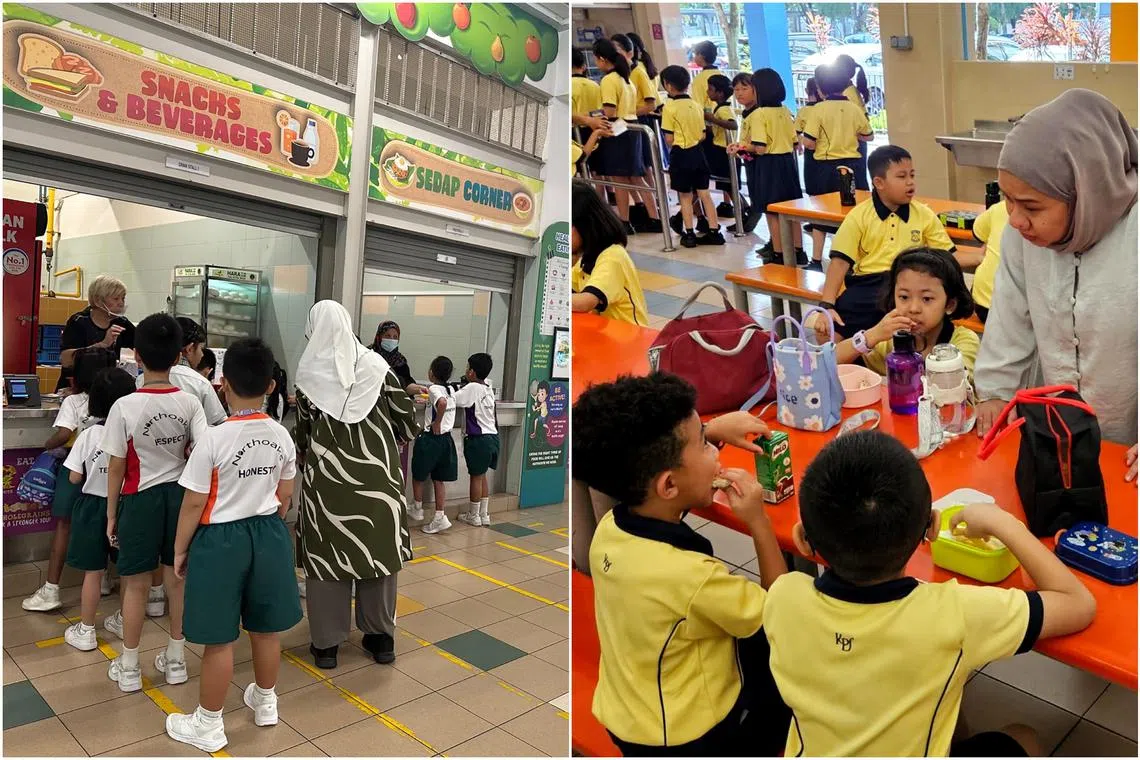Parents understand need for pre-packed meals in schools, but some prefer traditional canteen food
Sign up now: Get ST's newsletters delivered to your inbox

Northoaks Primary School and Kranji Primary School students eating their meals during recess time.
PHOTOS: NORTHOAKS PRIMARY SCHOOL, KRANJI PRIMARY SCHOOL
Follow topic:
- Some parents encourage children's financial literacy by giving allowances for canteen purchases.
- Schools face challenges attracting canteen stallholders, impacting students' opportunities to manage money.
- Pre-ordered meals offer convenience but can lead to menu fatigue and food waste for some students.
AI generated
SINGAPORE - When Mr Christopher Burgess’ son was enrolled in River Valley Primary School (RVPS), he would save up for a slice of pizza from the school canteen.
“We gave him a daily allowance of $1... But he liked to save up and buy a pizza slice that cost $2.
“Eventually, he and his friends ended up pooling their money to buy an entire pizza that 10 of them could share. They figured out that it was cheaper than if they’d all bought individual slices,” said Mr Burgess, a consultant.
He was one of several parents who were notified on Aug 15 that RVPS is among 13 schools that will be switching to a central kitchen model from 2026.
While most schools have an adequate number of canteen stalls, The Ministry of Education (MOE) said some schools are finding it increasingly difficult to attract stallholders to fill vacant stalls, even with low rental.
Mr Burgess said he felt a tinge of sadness that his Primary 2 daughter attending RVPS would miss out on canteen experiences that her older brother, who is now in Secondary 1, had.
“I want her to know the responsibility of being able to line up, managing her money and being able to choose... It’s empowering for a little eight-year-old to be able to have that agency and autonomy,” he said, though he added that he understands the school’s need for the change.
Another parent, who has two children in Primary 3 and Primary 6 in the same school, said she is glad the central kitchen meal model will address the canteen vendor shortage.
But she also has similar worries that her children will miss out on skills related to managing money.
“Without a canteen and having their meals pre-ordered, they won’t be able to practise paying, counting their change and saving,” she said.

Yusof Ishak Secondary School students taking meals from meal dispensers during recess on Sept 3.
ST PHOTO: AZMI ATHNI
A parent of a Primary 3 boy in RVPS, who wanted to be known only as Ms Angel, said she does not mind the change as long as the food is healthy.
At Northshore Primary School – which implemented an alternative meal service model earlier in 2025 – parents had a range of views about the school’s shift to pre-ordered meals.
According to the school’s website, pupils pre-order their meals online. The meals are then prepared and packed by airline catering and logistics company Sats.
A mother of a Primary 1 and Primary 5 pupil, who declined to be named, said: “At first, the children were excited because it was something new. But after six months, they got tired of the menu. It’s almost always the same.”
Mrs Ng, a homemaker with two sons in Primary 1 and Primary 3, said she felt the food options and portions provided were not suitable for young children.
“They use some sort of healthy mixed brown rice, which my kids are not used to eating. And as the portions are quite big, they usually cannot finish and end up wasting (the food),” she said. Also, if they forget to place an order in advance, they have to take their own food to school, she added.
Said Mrs Ng: “In the end, we stopped using it after a few months.”

The satay chicken with fried rice dish from Sats Food Services for Yusof Ishak Secondary School students during recess on Sept 3.
ST PHOTO: AZMI ATHNI
Other parents, like Mr Fariz, 37, an ambulance driver, appreciated the convenience and affordability of pre-packed meals. But he said that although the food is designed to be nutritious, it may not be to the liking of younger children.
Mr Fariz said: “They cannot be picky, they have to live with what they have.”
His children, who are in Primary 2 and Primary 5, feel differently about the school’s food options.
“My younger son loves it and says the food is nice,” he said. “But my daughter, not so much, especially since the meals come with vegetables.”


